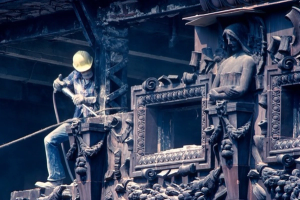The 2025 Fitch Colloquium, titled Fragments of the Imagination: Provenance, Preservation, and the Afterlives of Architecture, brings together leading voices in preservation, architecture, art history, museum practice, and the humanities to examine the conceptual, ethical, and artistic stakes of working with architectural fragments. Organized by Columbia University’s Graduate School of Architecture, Planning and Preservation (GSAPP) in collaboration with Provenance Projected the colloquium asks:
How might architectural fragments be mobilized to reimagine the built environment; not as static inheritance, but as a site of imaginative transformation? How can institutions such as museums, archives, and landmark commissions be rethought in light of the provenance and circulation of architectural fragments? How does provenance shape disciplinary knowledge and epistemologies within architecture, preservation, art, and beyond?
The colloquium will conclude with a concert in Columbia’s St. Paul’s Chapel of choral music from sixteenth-century Iberia. Curated by music historians Susan Boynton and Eric Rice, the program explores the afterlives of medieval chant. The music will be performed by University of Connecticut’s Collegium Musicum under the direction of Eric Rice, in collaboration with singers from the Department of Music at Columbia University.
SCHEDULE
10:00 Welcome & Introductions by Jorge Otero-Pailos, Mari Lending and Erik Langdalen
10:15–12:00
CUT: Recovering fragments and the ethics of architectural disassembly, moderated by Mari Lending
Lucian Simmons, Head of Provenance Research, The Metropolitan Museum of Art
Michael R. Allen, Visiting Assistant Professor of History, West Virginia University
Eleonora Pistis, Associate Professor of Art History, Columbia University
Albena Yaneva, Professor of Architectural Theory, Politecnico di Torino
12:00–13:20 Lunch
13:20–14:40
CARRY: Circulation, relocation, and the politics of provenance, moderated by Erik Langdalen
Tone Hansen, Director, Munch Museum, Oslo
Susan Boynton, Professor of Music, Columbia University
Uwe Fleckner, Professor of Art History, University of Hamburg/Director of Warburg-Haus
Evangelos Kotsioris, Assistant Curator, Architecture & Design, Museum of Modern Art, New York
14:40–15:00 Coffee Break
15:00–16:20
COMBINE: Integrating fragments into new narratives, pedagogies, and futures, moderated by Jorge Otero-Pailos
Giuseppe Lignano & Ada Tolla, Partners LOT-EK, Adjunct Associate Professors
Amandine Kastler & Erlend Skjeseth, Kastler Skjeseth Architects, Associate and Assistant Professor, Oslo School of Architecture and Design
Francisco Prado-Vilar, Distinguished Researcher, CISPAC, Uni. Santiago de Compostela
Amie Siegel, Artist
16:20–17:00 Closing Remarks
17:00–17:45 Concert in St. Paul’s Chapel
17:45–19:00 Cocktail Reception in Avery Plaza

